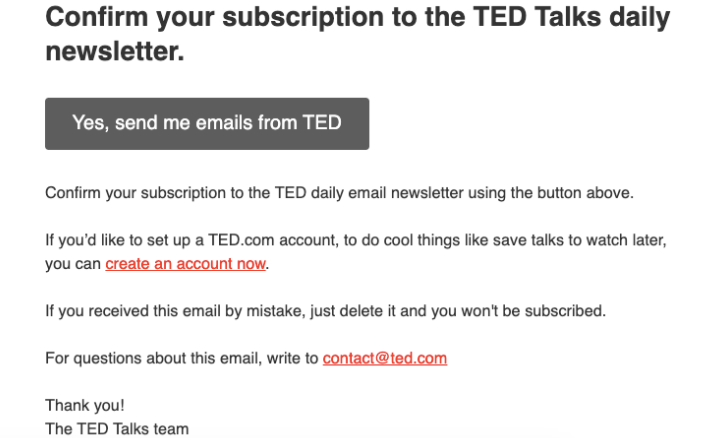There’s a longstanding debate among email marketers about which is better: single opt-in or double opt-in emails. Both sides offer pros and cons for an email marketing strategy.
However, a worldwide poll from Litmus found that 53.5% of email marketers prefer using single opt-in, while 46.5% favor using a double opt-in.
While single opt-in emails are slightly favored, many email marketers prefer the double opt-in approach to build “healthier” email lists and increase email campaign engagement.
Overview: What is a double opt-in?
The double opt-in method involves two steps:
Step 1: The user fills out a subscription form (which usually requires only an email address) and submits it to sign up.
For example, here is TED’s email sign-up page, where users can enter their email address to subscribe.
Users enter their email address in TED’s sign-up page for their daily newsletter. Image source: Author
Step 2: After submitting the form, users will receive a confirmation message containing a verification button or link they’ll need to use to complete the process.
This is what TED’s email confirmation looks like:

This is Image source: Author
TED’s double opt-in email confirmation after subscribing to their newsletter.
Only after clicking “Yes, send me emails from TED” will the user be subscribed to TED’s email list. By using the double opt-in method, email marketers can easily identify subscribers who are truly interested in their emails.
This process also removes spam addresses and users who are not keen on receiving your emails.
Double opt-in vs. single opt-in: What’s the difference?
Most email marketing software supports single opt-in and double opt-in subscriptions. Both methods are secure and easy ways to collect data and permission from your subscribers. The key difference is the need for confirmation.
In a single opt-in process, users need to enter their email address only once to officially subscribe. No email confirmation is required.
In a double opt-in process, users must enter their email address first, and then confirm via email to complete their subscription.
Most email marketers prefer the single opt-in method because it streamlines the process of subscribing and makes it convenient for users to join. It’s often used in email marketing for small businesses since it’s a quicker way to grow an email list.
Meanwhile, double opt-in makes growing your lists slower because 61% percent of people don’t complete the sign-up process, according to a study by Mailchimp.
That extra step in the process makes a difference.
Benefits of using double opt-in
Despite the disadvantages of using double opt-ins, veteran email marketers are still keen on using the subscription process because of its benefits.
1. Confirm the email addresses of your subscribers
Right from the start, a double opt-in process guards your email list against spam email accounts because all of your subscribers have confirmed email addresses.
Even though it’s a longer process, the quality of subscribers generated through double opt-ins far exceeds those resulting from single opt-ins. They have a higher likelihood of engaging and taking action on your offers.
Also, since you know your subscribers are real people and you don’t have to worry about scrubbing your list to eliminate spam accounts, it becomes easier to manage your email list.
2. Improve your list engagement
Double opt-ins not only ensure the email addresses in your list are correct and active, they also validate your subscribers’ genuine interest in receiving your emails. It demonstrates their eagerness to learn more about your brand and your offers — they wouldn’t have opted in twice if they weren’t really interested.
As a result, you get higher open and click rates in your email marketing campaigns.
In fact, a study conducted by Mailchimp revealed those who used a double opt-in approach had a 72.2% increase in unique opens and 114% uptick in clicks.
It’s crucial to identify your subscribers’ disposition. If they aren’t at all interested in your offers and have no intention of engaging, you’d be better off not having them in your list. If your web visitors subscribed to your email list by mistake, they’ll ignore you, no matter how engaging your email newsletter templates are.
3. Improve your email deliverability
When your emails are flagged as spam, your email marketing campaigns suffer. Your sender reputation, engagement rate, and email deliverability will spiral downward toward oblivion.
With a double opt-in process, your subscribers are less likely to flag your email as spam since they deliberately signed up to your newsletters and are expecting them. This isn’t always the case with single opt-ins.
Some subscribers sign up by mistake, and then tag your emails as spam when they receive your newsletters. Enough spam reports can land you on an email blacklist.
Internet service providers have become more stringent with filtering emails that seem like spam. That’s why it’s recommended to build a clean and active email list from the start using double opt-ins.
When should your business utilize double opt-in emails?
Deciding which email registration method fits your email marketing campaign will depend on your priorities.
Consider using a double opt-in approach in the following situations:
- You’re not focusing on numbers. Confirming email addresses makes the process of growing your email list longer and more roundabout. However, your subscribers are bound to engage and convert better.
- You’re experiencing low open rates. Your email open rates improve when your subscribers join your list through the double opt-in approach. If you have abysmal email open rates, and you want to improve your figures, try the double opt-in approach.
- You had previous abuse reports. If you’ve experienced being blacklisted or reported for spam trigger words, start a new and clean email list by using the double opt-in email method.
- You need to comply with regulations. Implement double opt-in if it’s required by your market or country’s data and privacy regulations.
Overall, if you’re aiming for quality contacts, use double opt-in emails.
Is double opt-in required by law?
Due to stricter data regulation policies, permission is required in email marketing. This means senders must get valid consent from contacts before sending promotional emails.
However, double opt-in emails are not a requirement under GDPR, CAN-SPAM, and CASL. Rather, it’s considered a best practice, especially in Germany and the European Union.
It’s worth pointing out that using double opt-in doesn’t guarantee GDPR compliance. To collect consent, be sure to insert a checkbox with consent clauses and a link to your privacy policy in your subscription section.
Vox’s newsletter subscription page is a good example of collecting consent and complying with data regulations.

Vox’s newsletter subscription page includes a consent checkbox and a link to their privacy policy. Image source: Author
By adding a checkbox, Vox ensures its subscribers consent to receiving emails and agree to Vox’s privacy policy and data transfer policy for European users.
To steer clear of any data privacy issues, comply with data privacy regulations, and use double opt-in as best practice.
Build and grow a healthy email list
Building an email list with active, engaging, and long-lasting subscribers can do wonders for your email marketing campaigns. Not only will you get better sales and engagement, but you also reduce your marketing costs, allowing you to enjoy a better return on investment for your email marketing.


